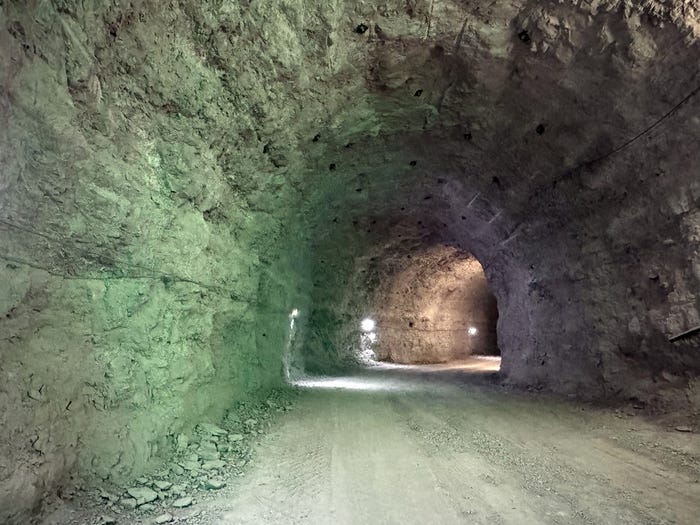A Look at the World’s First Data Center in an Active MineA Look at the World’s First Data Center in an Active Mine
Construction has begun on a 5MW data center located in an active mine in the Italian Alps. Industry experts weigh in on the facility – and the promise of underground data centers.

A unique data center in the Italian Alps will soon share space with dolomite extraction and quarries storing apples, wine, and cheeses. Construction began this month at the San Romedio mine in Trento, Italy on Intacture, a 5MW facility that will host approximately 1,000 racks. Intacture is set to support colocation services starting in 2026.
The result of a public-private collaboration between the University of Trento and the technology company Trentino DataMine, the data center center – which will cost about 50 million euros – is partly funded by the country’s Recovery and Resilience Plan (NRRP).
Stakeholders and industry experts weighed in on the project and its implications for other data centers, both above and below ground.
.png?width=700&auto=webp&quality=80&disable=upscale)
A mockup of the outside of the Intacture data center facility. Credit: InSite
The Benefits of Going Underground
Although the Intacture facility is claimed to be the world’s first data center in an active mine, this isn’t the first time the industry has turned its attention underground, said Alan Howard, principal analyst of cloud & colocation services at OMDIA. He pointed to examples such as the Green Mountain data center in Rennesoy, Norway, the Bahnhof data center in Stockholm, and he underground Iron Mountain data center in the US.
But Howard said these projects are still relatively rare because of the types of infrastructure they need to have in place, such as roads, electricity, water, and a facility management function.

A photo from inside the underground Intacture facility. Credit: Trentino DataMine
But when those conditions are met, underground facilities can have major advantages over their above-ground counterparts, according to Howard. “A combination of constant, year-round low ambient temperature resulting in free cooling… and [being] naturally sheltered from severe weather and natural disaster scenarios” gives these underground data centers the potential to be cost- and energy-efficient, he said.
Iron Mountain’s data center in Pennsylvania, for example, is in a former limestome quarry that makes use of a large underground lake that doesn’t draw from the neighbouring community system, according to Chris Pennington, the company’s director of energy and sustainability.
“The effectiveness of utilizing the lake helped the site become the first underground facility in the US to receive an Energy Star Certification,” Pennington said.
A video preview of the Intacture facility:
When speaking about the San Romedio mine, Roberto Loro, a Trentino DataMine board member, emphasized the many benefits of housing a data center deep underground.
“It offers maximum physical protection, eliminating seismic and hydrogeological risks,” Loro told Data Center Knowledge. He added that going underground means “energy savings of more than 25% compared to the European average and up to 40% compared to Mediterranean countries. The underground design drastically reduces land consumption, with more than 80% of the structures located inside the mine.”
.png?width=700&auto=webp&quality=80&disable=upscale)
A mockup visualizing the underground layout of the Intacture facility. Credit: InSite
'An Unusual Collaboration' Between Research and Industry
Another novel facet of the future-oriented Intacture facility is the collaborative nature of the project itself, said Flavio Deflorian, rector of the University of Trento.
“The very process of launching this initiative through a public-private partnership is in itself a challenge for the university system – a test of its ability to be flexible and to listen to the needs of the community and the business world,” He said. The role the university plays, Deflorian told Data Center Knowledge, is not only in the research the data center aims to power, but “to act as a promoter, [and] a facilitator…of innovation [and] of development.”
.png?width=700&auto=webp&quality=80&disable=upscale)
An aerial mockup view of the 5MW Intacture data center facility. Credit: InSite
“[Our] goal is to bring the world of industry and the marketplace into dialogue with the world of research to find innovative solutions that will have a place in the marketplace in the future,” a spokesperson for Trentino DataMine told Data Center Knowledge. While construction on Intacture is still in its first phase, the technology company is already looking to the data center’s future as a potential green hub of innovation not only for the region, but for the entire country.
“The facility may evolve to offer services beyond colocation. The University of Trento and the research ecosystem in the Trentino region will use the facility for research activities,” they said.
As mentioned, the Intacture data center is designed for a maximum power of 5MW and will host a total of approximately 1,000 racks. “That won’t support large-scale deployments we might see from hyperscalers,” Omdia’s Howard said. But the project, he predicts, should have success as a resource for local customers.
“There is surely fiber running through the community, which should provide connectivity to data centers in Milan,” he said, “[giving] their customers broad global network connectivity.”
Read more about:
EuropeAbout the Author
You May Also Like









